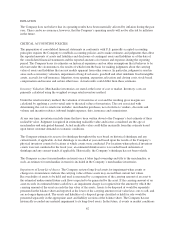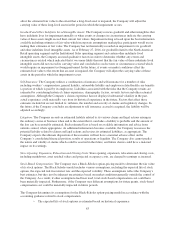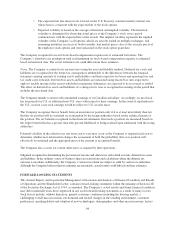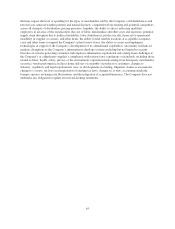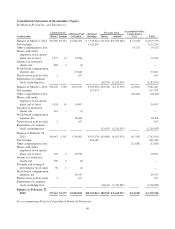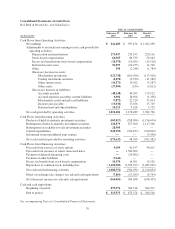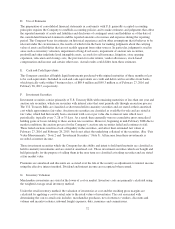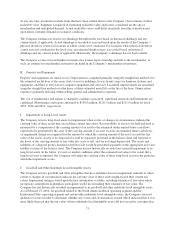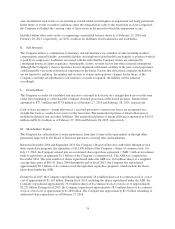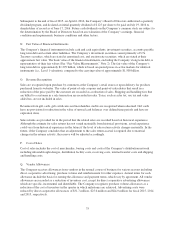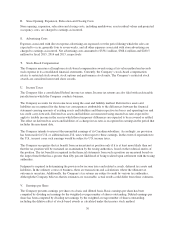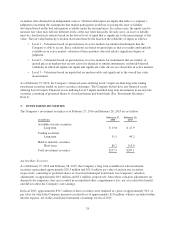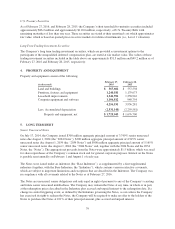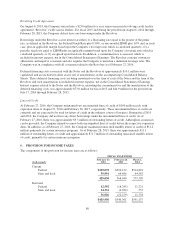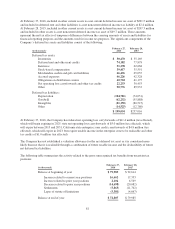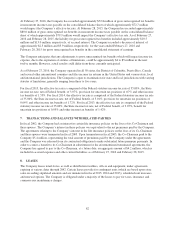Bed, Bath and Beyond 2015 Annual Report Download - page 84
Download and view the complete annual report
Please find page 84 of the 2015 Bed, Bath and Beyond annual report below. You can navigate through the pages in the report by either clicking on the pages listed below, or by using the keyword search tool below to find specific information within the annual report.D. Use of Estimates
The preparation of consolidated financial statements in conformity with U.S. generally accepted accounting
principles requires the Company to establish accounting policies and to make estimates and judgments that affect
the reported amounts of assets and liabilities and disclosure of contingent assets and liabilities as of the date of
the consolidated financial statements and the reported amounts of revenues and expenses during the reporting
period. The Company bases its estimates on historical experience and on other assumptions that it believes to be
relevant under the circumstances, the results of which form the basis for making judgments about the carrying
value of assets and liabilities that are not readily apparent from other sources. In particular, judgment is used in
areas such as inventory valuation, impairment of long-lived assets, impairment of auction rate securities,
goodwill and other indefinite lived intangible assets, accruals for self insurance, litigation, store opening,
expansion, relocation and closing costs, the provision for sales returns, vendor allowances, stock-based
compensation and income and certain other taxes. Actual results could differ from these estimates.
E. Cash and Cash Equivalents
The Company considers all highly liquid instruments purchased with original maturities of three months or less
to be cash equivalents. Included in cash and cash equivalents are credit and debit card receivables from banks,
which typically settle within 5 business days, of $89.4 million and $90.3 million as of February 27, 2016 and
February 28, 2015, respectively.
F. Investment Securities
Investment securities consist primarily of U.S. Treasury Bills with remaining maturities of less than one year and
auction rate securities, which are securities with interest rates that reset periodically through an auction process.
The U.S. Treasury Bills are classified as short term held-to-maturity securities and are stated at their amortized
cost which approximates fair value. Auction rate securities are classified as available-for-sale and are stated at
fair value, which had historically been consistent with cost or par value due to interest rates which reset
periodically, typically every 7, 28 or 35 days. As a result, there generally were no cumulative gross unrealized
holding gains or losses relating to these auction rate securities. However, beginning in mid-February 2008 due to
market conditions, the auction process for the Company’s auction rate securities failed and continues to fail.
These failed auctions result in a lack of liquidity in the securities, and affect their estimated fair values at
February 27, 2016 and February 28, 2015, but do not affect the underlying collateral of the securities. (See “Fair
Value Measurements,” Note 2 and “Investment Securities,” Note 3). All income from these investments is
recorded as interest income.
Those investment securities which the Company has the ability and intent to hold until maturity are classified as
held-to-maturity investments and are stated at amortized cost. Those investment securities which are bought and
held principally for the purpose of selling them in the near term are classified as trading securities and are stated
at fair market value.
Premiums are amortized and discounts are accreted over the life of the security as adjustments to interest income
using the effective interest method. Dividend and interest income are recognized when earned.
G. Inventory Valuation
Merchandise inventories are stated at the lower of cost or market. Inventory costs are primarily calculated using
the weighted average retail inventory method.
Under the retail inventory method, the valuation of inventories at cost and the resulting gross margins are
calculated by applying a cost-to-retail ratio to the retail values of inventories. The cost associated with
determining the cost-to-retail ratio includes: merchandise purchases, net of returns to vendors, discounts and
volume and incentive rebates; inbound freight expenses; duty, insurance and commissions.
72


